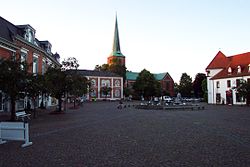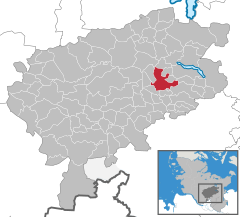Bad Segeberg | |
|---|---|
 | |
Location of Bad Segeberg within Segeberg district  | |
| Coordinates: 53°55′N 10°19′E / 53.917°N 10.317°E | |
| Country | Germany |
| State | Schleswig-Holstein |
| District | Segeberg |
| Government | |
| • Mayor | Dieter Schönfeld (SPD) |
| Area | |
• Total | 18.87 km2 (7.29 sq mi) |
| Elevation | 27 m (89 ft) |
| Population (2022-12-31)[1] | |
• Total | 18,221 |
| • Density | 970/km2 (2,500/sq mi) |
| Time zone | UTC+01:00 (CET) |
| • Summer (DST) | UTC+02:00 (CEST) |
| Postal codes | 23781–23795 2360 |
| Dialling codes | 04551 |
| Vehicle registration | SE |
| Website | www.badsegeberg.de |
Bad Segeberg (German: [baːt ˈzeːɡəˌbɛʁk] ; Low German: Sebarg) is a German town of 16,000 inhabitants, located in the state of Schleswig-Holstein, capital of the district (Kreis) Segeberg. It is situated approximately 50 kilometers (31 mi) northeast of Hamburg, and 25 kilometers (16 mi) west of Lübeck.
It is famous for its annual Karl May Festival, which takes place in the town's Kalkberg Stadium, a large amphitheater originally built by the Reich Labour Service into an exploited quarry at the Segeberger Kalkberg.
There is a large television tower in the middle of the town.


